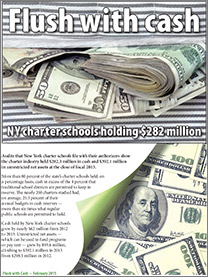Analysis: New York charter schools flush with cash
ALBANY, N.Y. February 2, 2015 - New York's charter schools are flush with cash, holding $282.3 million in taxpayers' money in the bank and $392.1 million in unrestricted net assets that can be used to pay for rent and academic programs, according to a new analysis by New York State United Teachers. One Long Island charter school alone had banked $21 million in cash savings at the close of fiscal 2013.
 The analysis also shows 82 percent of the state's charters held, on a percentage basis, cash in excess of the 4 percent that traditional school districts are permitted to keep in reserve. The nearly 200 charters studied had, on average, 25.3 percent of their annual budgets in cash reserves - more than six times what regular public school districts are permitted to keep. Five charter schools had enough cash in the bank at the close of fiscal 2013 to fund more than a year of operations without any new revenue.
The analysis also shows 82 percent of the state's charters held, on a percentage basis, cash in excess of the 4 percent that traditional school districts are permitted to keep in reserve. The nearly 200 charters studied had, on average, 25.3 percent of their annual budgets in cash reserves - more than six times what regular public school districts are permitted to keep. Five charter schools had enough cash in the bank at the close of fiscal 2013 to fund more than a year of operations without any new revenue.NYSUT President Karen E. Magee said the charter industry's push for additional per-pupil and facilities money is undermined by their own financial accounting, which shows the current funding formula is more than adequate to meet charters' needs.
"It's the definition of 'chutzpah' for the charter industry to be crying poverty and demanding ever more state funding when their own balance sheets show that most individual charter schools are rolling in cash and have tidy savings in the bank," Magee said. "Instead of siphoning money from traditional public schools, maybe charters should first use the cash stashed in their mattresses."
Magee added that Gov. Andrew Cuomo's budget proposal to give charters more state funding at a time when scores of districts are facing fiscal stress suggests he is trying to reward his billionaire hedge fund backers - many of whom sit on charter school boards - rather than address the real funding needs of traditional public schools that serve 97 percent of public school students. "It certainly appears the governor is more interested in rewarding his billionaire friends who bankroll the charter lobby than providing the adequate and equitable state funding that all kids need," she said.
NYSUT Executive Vice President Andrew Pallotta said the union's analysis of charter balance sheets demonstrates why the charter industry must be held to stricter standards of accountability and transparency. "Charters are public schools. Yet, because local taxpayers have no say in how charter boards are appointed and there is no local budget vote and accompanying scrutiny, many charters are getting away with stockpiling money," Pallotta said. "Taxpayers have every right to know their tax dollars are being used wisely. At a time when our school districts are starved for funding - and inequality is at record levels - it's outrageous that individual charters are, in many cases, sitting on piles of cash while students in traditional public schools are doing without. Charters with extra money should be using those assets to invest in programs for their students and to treat their teachers fairly."
NYSUT analyzed renewal reports, tax returns and audits that charter schools were required to file with their authorizers for 2011-12 and 2012-13. The reports became available in Fall 2014 and are the latest available for public scrutiny. Although no data is available for several dozen charters - many of them new - the NYSUT findings show the charter industry has no need for additional funding.
The amount of cash held by charters is growing rapidly, as are the charters' unrestricted net assets, which can be used for a variety of purposes. The $282.3 million in cash held by the state's charter industry grew by about $61 million from 2012, when charter schools reported having $221 million in cash on hand. Unrestricted net assets held by charter schools grew by about $93 million, from $298.5 million in 2012 to $392.1 million in 2013, according to the review of charter audits.
Ironically, the charters that tend to hold the least amount of cash are generally those connected with large networks. Charter networks, such as Success Academy, bill their individual schools per-pupil "management fees," sometimes more than $2,000 per student. Still, the Success network Analysis: New York charter schools flush with cash | NYSUT.org:


